Carcinoembryonic Antigen: A Key Biomarker in Oncology
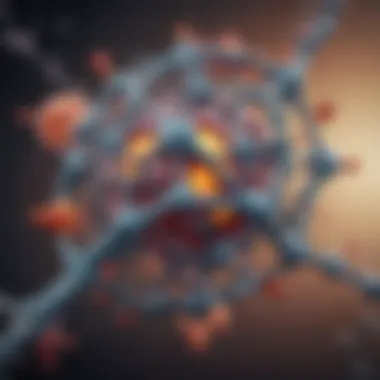
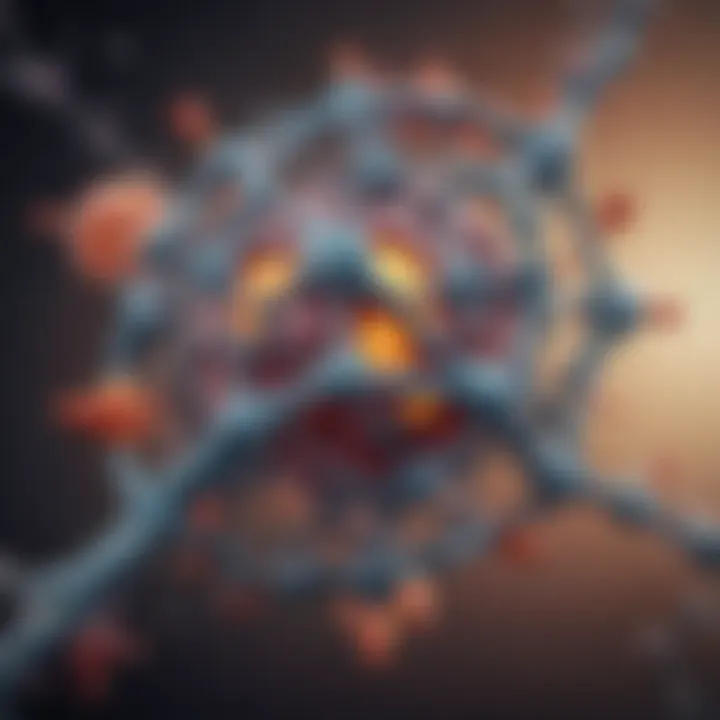
Intro
Carcinoembryonic antigen (CEA) has come to the forefront in the realms of oncology and diagnostics, emerging as an essential biomarker in understanding various disease states. It might initially sound like a buzzword thrown around in medical circles, but CEA brings significant implications for patient care, diagnosis, and treatment evaluation. The utility of CEA extends beyond just colorectal cancer, where it first gained recognition. Today, its relevance spans a wide array of malignancies and even some non-cancerous conditions. This article intends to peel back the layers of CEA, shedding light on its historical origins, biological functions, and its role in modern medical practices.
Understanding CEA and what it signifies can equip healthcare professionals and researchers with the tools they need to navigate complex clinical scenarios. This is not just about statistics and lab results; it's about weaving a narrative that reflects the challenges and opportunities in patient management. By the end of this exploration, readers will not only grasp the technicalities of CEA but also appreciate its broader implications across multiple disciplines.
Understanding Carcinoembryonic Antigen
Understanding carcinoembryonic antigen (CEA) is akin to deciphering the complex language of cancer biology. CEA serves as a critical beacon in oncology, illuminating pathways for diagnosis, prognosis, and treatment monitoring. Given its origins in colorectal cancer, it has now expanded its relevance across a diverse range of malignancies and non-cancerous conditions. By grasping the intricacies of CEA, healthcare professionals and researchers can better navigate patient care and treatment complexities.
Definition and Historical Context
Carcinoembryonic antigen was first discovered in the early 1960s during studies focused on colorectal cancer. Researchers identified this glycoprotein in the serum of patients with intestinal tumors. Named for its embryonic characteristics, CEA was initially thought to be absent in healthy adults, only appearing in embryonic development and certain cancers. Over the decades, the understanding of CEA has evolved, revealing its presence in healthy individuals and its varying levels in different diseases. This historical context sets the stage for the biomarker's growing significance in oncology and medical research.
Biochemical Properties
The biochemical properties of carcinoembryonic antigen are fundamental to its function as a biomarker. It is primarily a glycoprotein, which means it's made up of a protein backbone attached to carbohydrate chains. To understand why this matters, let's examine two key components: the structure of CEA and its glycosylation patterns.
Structure of CEA
The structure of carcinoembryonic antigen is an essential aspect that contributes to its classification as a tumor marker. This protein has a molecular weight of about 180 kDa and is composed of multiple domains, which are thought to play critical roles in its biological activities. One intriguing characteristic of CEA is its ability to mediate cell adhesion, a property that can influence tumor progression and metastasis.
CEA's structural configuration allows it to participate actively in cellular interactions, making it a topic of interest in cancer research. The benefits of understanding CEA's structure extend beyond academic curiosity; they pave the way for targeted therapies and improved diagnostic pathways in oncology. However, the complexity of its structure may also pose challenges in developing standard assays, which require precise translation of this information into clinical settings.
Glycosylation Patterns
The glycosylation patterns observed in carcinoembryonic antigen profoundly influence its effectiveness as a biomarker. Glycosylation refers to the attachment of sugar moieties to the protein. These sugar chains can vary, impacting the protein's stability, immunogenicity, and interaction with receptors. Notably, altered glycosylation patterns of CEA have been implicated in its elevated presence in malignant conditions.
One of the critical characteristics of CEA's glycosylation is how it changes during tumor progression. This variability denotes a unique feature; it can signal disease dynamics and possibly predict patient outcomes. Recognizing these patterns provides valuable insight into cancer biology, helping clinicians make informed decisions about patient management. However, glycosylation also introduces variability into test results, posing the disadvantage of inconsistent diagnosis across different laboratories. This complexity must be acknowledged in discussions surrounding clinical applications of the biomarker.
Role of CEA in Oncology
Carcinoembryonic antigen (CEA) plays a critical role in oncology, essentially acting like a lighthouse guiding clinicians through the murky waters of cancer diagnosis and management. Its significance stretches far beyond a mere biomarker; it embodies a wealth of information that can inform treatment decisions and patient outcomes. By examining not only colorectal cancer, which was its initial association, but also its implications in various malignancies, we gain a deeper understanding of its multifaceted nature. CEA becomes a valuable tool in both the clinical and research arenas, paving the way for advancements in personalized medicine and enhanced patient care.
Association with Colorectal Cancer
Diagnostic Utility
The use of CEA in diagnosing colorectal cancer is a cornerstone of oncology practice. When clinicians suspect cancer, measuring CEA levels serves as a critical aspect of the diagnostic puzzle. One of the key characteristics of this utility is its responsiveness to tumor presence; elevated levels often correlate with cancerous activity. This makes CEA an attractive option for healthcare providers.
A unique feature of the diagnostic utility is its ability to provide early indications of disease. While imaging techniques are also critical, CEA levels can signal abnormalities even before physical changes can be observed. However, its limitations come to light when considering a range of factors that may also influence CEA levels, such as non-malignant conditions. Healthcare professionals must thus tread carefully, balancing these complexities when interpreting results.
Prognostic Relevance
Moving beyond diagnostics, CEA holds substantial prognostic relevance. This means that CEA levels can offer insights into the likely trajectory of the disease. For instance, patients with higher baseline levels of CEA may face poorer outcomes, acting almost like a warning sign. The pivotal characteristic here lies in its monitoring ability; consistent tracking of CEA can provide valuable information on disease progression or remission.
A defining aspect of prognostic relevance lies in the fact that CEA levels can inform treatment adjustments. Should the CEA trend upward during therapy, it could indicate the need for a change in strategy or intervention. However, it’s crucial to realize that while CEA can be a useful prognostic marker, over-reliance on this single biomarker can be misleading in some cases. Variability in individual responses to treatment can alter CEA levels independently of actual cancer behavior.
Implications in Other Cancers
Lung Cancer
The role of CEA is not confined to colorectal cancer; for lung cancer, its presence can also give important clues. Elevated CEA levels have been observed in non-small cell lung cancer, making it a point of interest in both diagnosis and management. The unique feature of this connection lies in the non-invasive nature of CEA measurement, which can serve as a helpful adjunct to imaging studies and other diagnostic tools.
Advantages of using CEA in lung cancer include its ability to offer a quick snapshot of tumor activity. However, similar to its role in colorectal cancer, the drawback is that elevated levels can also stem from non-malignant lung conditions, adding layers of complexity in interpretation.
Breast Cancer
When it comes to breast cancer, the implications of CEA levels are often debated. While some studies have shown a correlation between elevated CEA and more advanced stages of the disease, the biomarker is not universally accepted as a standard indicator. One significant aspect of CEA in breast cancer is its potential to track treatment response.
The distinct advantage here lies in its complementarity with other tests, like hormone receptors or HER2 status. However, its limitations are evident, as not all breast cancer subtypes will show elevated CEA, suggesting its inconsistent nature in this context.
Pancreatic Cancer
Pancreatic cancer presents one of the most challenging scenarios in oncology, and the utility of CEA can be quite variable. In some cases, elevated levels may signal the presence of this aggressive cancer, providing crucial information for clinicians. What distinguishes CEA in pancreatic cancer is its role as part of a larger diagnostic strategy, combining biochemical markers with imaging techniques.
On one side, CEA can contribute to early detection efforts, which is critical given the often late presentation of symptoms in pancreatic cancer. On the flip side, its specificity may not be high enough for it alone to serve as a definitive diagnosis, as other benign conditions may also cause elevated levels.


"While CEA has its strengths, it must be used judiciously alongside other diagnostic and prognostic tools in oncology."
"While CEA has its strengths, it must be used judiciously alongside other diagnostic and prognostic tools in oncology."
In summary, CEA's role in oncology extends far beyond its initial identification with colorectal cancer, establishing its relevance across a spectrum of malignancies. This intricate interplay fundamentally shapes our understanding and approach to treatment strategies.
Mechanisms of CEA Expression
The understanding of how carcinoembryonic antigen (CEA) is expressed within the body is crucial for grasping its role in both health and disease. CEA levels can shift dramatically based on various biological processes occurring in tissues, which underscores the complexity of its utility as a biomarker. The mechanisms behind CEA expression not only illuminate its significance but also expand potential avenues for therapeutic interventions. By delving into these mechanisms, researchers and clinicians can better leverage CEA in the diagnosis, treatment monitoring, and overall management of different medical conditions.
Differentiation of Bowel Epithelium
The differentiation process of bowel epithelium stands as a pivotal factor in CEA expression. During normal embryonic development, the bowel epithelium undergoes complex changes that influence its cellular composition and functional characteristics. In this context, CEA manifests its properties predominantly in the epithelial cells of the colorectal region, where it embodies a marker of differentiation and maturation. Consequently, the levels of CEA can act as indicators of normal cellular processes as well as abnormal transformations, such as those found in neoplastic conditions.
Further, the context of bowel epithelium differentiation underlies its responsiveness to various stimuli, which can include inflammation or tumorigenic factors. Hence, fluctuations in CEA levels can reflect changes not just within the cancerous tissues but also in adjacent healthy tissues responding to neoplastic challenges.
Tumor Microenvironment Influence
The tumor microenvironment plays a fundamental role in shaping CEA expression through various pathways and mechanisms. Not limited to just a byproduct of malignancy, CEA levels can be modulated by the interplay between tumor cells and their surrounding stroma.
Immune Response Modulation
One notable aspect of immune response modulation is its dual capacity to enhance or suppress CEA levels depending on the specific immune context. Tumor-infiltrating lymphocytes, for example, can either upregulate or downregulate CEA expression through cytokine signaling and cell-to-cell interactions. This key characteristic makes immune modulation vital, as understanding how immune cells influence CEA can guide the development of immunotherapies aimed at restoring normal immune functions in cancer patients.
However, a potential drawback lies in the variability of immune responses among individuals. Immune profiles can differ significantly, leading to inconsistent CEA levels, which may challenge its reliability as a biomarker across different populations.
Inflammation and CEA Levels
Inflammation is another critical factor affecting CEA levels, highlighting its position in not just cancer biology but also in broader biological processes. Elevated levels of CEA during inflammation can complicate the diagnostic process, leading to false elevations in benign conditions, such as chronic inflammatory diseases. This unique feature of CEA increases its complexity as a marker. While it reflects ongoing pathological processes, one must approach its interpretation carefully, especially in cases where inflammatory diseases co-exist with malignancy.
The upside is that by monitoring CEA levels in conjunction with inflammatory markers, healthcare professionals can gain insights into patient conditions that go beyond tumor activity alone. Yet, the caveat remains that distinguishing between cancer-related elevation and inflammation-induced elevation can pose diagnostic challenges.
In scientific exploration, understanding the mechanisms of CEA expression not only enhances biomarker reliability but also provides a path for developing targeted therapies and personalized treatment strategies.
In scientific exploration, understanding the mechanisms of CEA expression not only enhances biomarker reliability but also provides a path for developing targeted therapies and personalized treatment strategies.
In summary, the mechanisms driving CEA expression are multifaceted. From the differentiation of bowel epithelium to the influences of the tumor microenvironment, these factors contribute significantly to CEA’s role as a biomarker. As research progresses, the complexities of these mechanisms will continue to reveal new insights into the clinical applications of CEA in oncology and beyond.
Clinical Applications of CEA Measurement
Carcinoembryonic antigen (CEA) plays a crucial role in the clinical setting, especially in oncology. Understanding its applications can significantly enhance patient care and treatment strategies. In this section, we will explore two primary clinical applications: screening and early detection, and monitoring treatment response. Each of these applications contributes valuable insights that can guide therapeutic interventions and overall management of cancer patients.
Screening and Early Detection
CEA measurement serves as an important tool for screening and early detection of certain cancers, particularly colorectal cancer. Elevated CEA levels can be indicative of malignancy, making it a potential flag to pursue more definitive diagnostic measures, like imaging or biopsies. This is especially advantageous given that early detection of cancer has been closely associated with improved prognoses.
However, one must be cautious. Elevated CEA levels can also arise from non-malignant conditions, leading to potential misinterpretations. Clinical practitioners often emphasize the necessity of triangulating CEA levels with other diagnostic methods. This ensures that those who need urgent care receive it, while others can be reassured.
- Benefits of CEA Screening:
- Acts as a complementary tool alongside other screening methods.
- Can lead to earlier diagnosis of certain cancers.
- Assists in the stratification of patients who may require further invasive evaluation.
Monitoring Treatment Response
When it comes to monitoring how effectively a patient responds to treatment, CEA levels can offer crucial insights. The trends observed in CEA measurements during therapy can help clinicians gauge whether a treatment is working or if adjustments are necessary. Let’s look at some specific aspects of this monitoring process.
Biomarker Trends during Therapy
Monitoring biomarker trends during therapy is paramount in adjusting treatment plans in real-time. CEA levels can indicate how well a cancer treatment is performing. For instance, a marked decline in CEA levels could suggest that the therapeutic regimen is successfully targeting the tumor. Conversely, a rise might trigger the consideration of alternative therapies.
One key characteristic of monitoring CEA levels is their ability to provide timely feedback. Reports indicate that frequent CEA assessments can offer insights into not just the efficacy of treatment but also help in early detection of recurrence, should it arise. This feedback loop equips medical teams with actionable data on patient status, allowing for personalized adjustments to therapy.
- Unique Feature of Trends:
- Provides quantifiable data to gauge treatment effectiveness.
- Allows for early adjustments to treatment plans to enhance overall outcomes.
Recurrent Disease Detection
Recognizing recurrence is critical in cancer care, and recurrent disease detection through CEA measurement serves as a proactive approach. When a patient’s CEA levels begin to rise after a treatment period, this can serve as an early warning sign of disease return, prompting further investigation and timely therapeutic intervention.
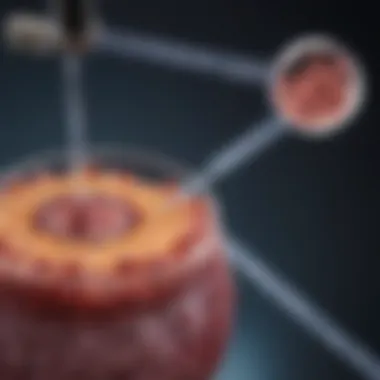
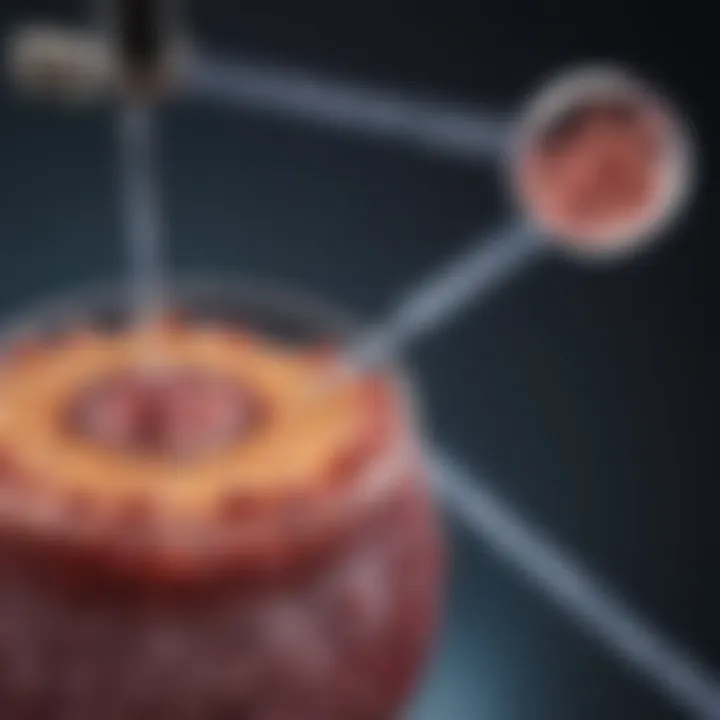
The ability to detect recurrence early is a distinctive feature of using CEA as a monitoring tool. It provides a non-invasive option, reducing the need for immediate costly imaging or invasive procedures. Early intervention can often lead to better recovery probabilities.
- Advantages of Recurrent Detection:
- Non-invasive and cost-effective monitoring approach.
- Facilitates timely intervention, potentially improving patient outcomes.
Quote: "Regular monitoring of CEA can be as helpful as a smoke alarm, alerting us to potential issues before they become fires."
Quote: "Regular monitoring of CEA can be as helpful as a smoke alarm, alerting us to potential issues before they become fires."
Parameters Affecting CEA Levels
The study of carcinoembryonic antigen (CEA) levels transcends mere tumor markers, diving into a myriad of factors that can influence these markers, subsequently guiding clinical decision-making. Understanding what impacts CEA levels is paramount for interpreting test results accurately. Factors affecting CEA levels can arise from both malignant and non-malignant conditions, and they often inform how CEA should be viewed in the context of patient diagnostics and treatment response. This section lays out the fundamental parameters influencing CEA fluctuations and their implications for clinicians and researchers alike.
Non-malignant Conditions Influencing CEA
Chronic Inflammatory Diseases
Chronic inflammatory diseases can significantly elevate CEA levels, often complicating the clinical picture. In conditions like rheumatoid arthritis or Crohn's disease, the body undergoes prolonged inflammatory responses. This characteristic raises the baseline levels of CEA, prompting a careful evaluation in patient responses. A notable aspect worth mentioning is that while elevated CEA levels can indicate malignancy, these chronic settings reflect non-specific inflammation, which can be misleading during interpretations. The unique feature of chronic inflammation means that practitioners must interpret CEA levels within the broader context of each patient’s health status to avoid pitfalls in assessment.
- Advantages: By recognizing the influence of chronic inflammatory states on CEA levels, clinicians can avoid misdiagnosing cancer or misjudging treatment efficacy.
- Disadvantages: The non-specific nature of elevated CEA can lead to uncertainty, prompting further unnecessary investigations.
Liver Disease
Liver diseases, ranging from cirrhosis to hepatitis, also pose a substantial impact on CEA levels. The liver plays a crucial role in the clearance and metabolism of various proteins, including antigens. In liver-related ailments, the disruption of this function can lead to an increase in CEA production. A key characteristic of liver disease is the interplay between liver function and systemic inflammation, as this affects not just CEA but several biomarkers relevant to oncology.
- Advantages: Understanding the relationship between liver health and CEA levels can lead to improved patient monitoring and better-informed therapeutic decisions.
- Disadvantages: The challenge lies in distinguishing between cancer-related and liver disease-related increases in CEA, which can lead to diagnostic confusion.
Pregnancy and Other Physiological Factors
Normal CEA Variation
Expecting mothers often witness fluctuations in their CEA levels during pregnancy. This phenomenon arises due to the physiological changes occurring in a woman’s body, which alters several metabolic processes. CEA can naturally rise during pregnancy, leading to the possibility of misunderstandings when interpreting results. The key characteristic of normal CEA variation lays in its benign nature, signaling that elevated levels do not always equate to malignancy in pregnant women.
- Advantages: Recognizing these variations empowers healthcare providers to interpret CEA tests more accurately, safeguarding against unwarranted anxiety for patients.
- Disadvantages: Misinterpretation during pregnancy may lead to overzealous and unnecessary follow-up tests that create stress for the mother.
Age and Gender Differences
Age and gender also play crucial roles in determining CEA levels. Research suggests that levels tend to rise with age, potentially due to increased underlying pathologies that are more prevalent in older populations. Additionally, gender differences might present as higher CEA levels in men compared to women, possibly linked to variations in genetic makeup or hormonal influences.
The implications here are twofold: clinicians must be attuned to these demographics while evaluating CEA levels, understanding that what is considered "normal" may shift based on a patient's gender or age. This awareness can enhance diagnostic accuracy and patient care.
- Advantages: Age and gender-specific reference ranges can fine-tune CEA interpretations, improving detection rates for malignancies.
- Disadvantages: Varied levels among demographics mean that clinicians must exercise discretion and comprehensive patient history in interpreting data rather than relying on static benchmarks.
Methodologies for CEA Testing
The methodologies for testing carcinoembryonic antigen (CEA) are vital in understanding and utilizing this biomarker effectively in both clinical and research contexts. As CEA is relevant not just in oncology but also in various non-malignant conditions, having reliable and precise testing methods is crucial. These methodologies determine the accuracy of the results that could influence diagnosis, treatment decisions, and ongoing monitoring of patients. Understanding how these techniques differ, their benefits, and any potential downsides can empower healthcare professionals to make informed choices in practice.
Assay Techniques
When it comes to measuring CEA levels, two prominent techniques are typically employed: immunoassays and liquid chromatography. Let’s break these down.
Immunoassays
Immunoassays are a cornerstone in the field of biomarker testing, and for good reason. This method utilizes antibodies that specifically bind to CEA, ensuring sensitivity and specificity in detecting this antigen. One of the key characteristics of immunoassays is their ability to process multiple samples at once, making them a popular choice in clinical labs.
A unique feature of immunoassays is their versatility; various formats like ELISA (Enzyme-Linked Immunosorbent Assay) can be adapted to suit different circumstances. This adaptability is beneficial, allowing labs to optimize their procedures depending on the patient population or the specific CEA assay they are implementing. However, they aren't without limitations. The potential for cross-reactivity with other antigens may lead to false positives, which requires careful consideration in clinical interpretation.
Liquid Chromatography
On the other hand, liquid chromatography presents an analytical approach that separates CEA from other serum components. It’s particularly useful for achieving high specificity and accuracy in quantifying CEA, making it a valuable choice, especially in research settings where precise measurements are necessary.
The defining characteristic of liquid chromatography is its dynamic separation, effectively isolating CEA based on its chemical properties. This means that it can provide a clearer picture of the biomarker's true concentration in biological samples. However, the trade-off is that this technique tends to be more time-consuming and requires sophisticated equipment, which can limit accessibility in some healthcare environments.
Interpretation of Results
Interpreting CEA test results accurately is as critical as the testing itself. It’s not only about the number on the paper; understanding the clinical context and optimal thresholds is just as vital.
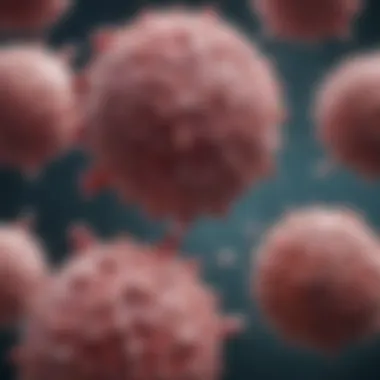

Optimal Thresholds
First, let’s consider optimal thresholds of CEA levels. These thresholds aren’t one-size-fits-all; they need to be tailored based on clinical guidelines and the patient demographic. The key characteristic of establishing appropriate thresholds is their role in optimizing the balance between sensitivity and specificity. A well-defined threshold improves the detection of true positives in cancer patients while minimizing false alarms in healthy individuals.
The advantage of setting optimal thresholds is clear; they provide a framework for clinicians to make informed decisions and tailor patient management strategies. However, baseline variations in CEA levels based on factors like age and gender must be navigated carefully to avoid misinterpretation.
Clinical Context Considerations
Lastly, when interpreting results, clinical context considerations cannot be overlooked. This encompasses not just the numerical value but also a myriad of factors like the patient's history, other laboratory findings, and the presence of concurrent conditions.
The unique feature here is the need for holistic evaluation. A specific CEA level interpreted in isolation could lead down the wrong path. For instance, elevated levels might necessitate further investigation but not necessarily imply cancer presence if another illness is at play.
In summary, understanding the methodologies of CEA testing and the intricacies involved in interpreting results is essential for effective patient care. As research continues, refining these methods will lead to better outcomes across various clinical settings, underlining the importance of robust methodologies and informed interpretation in the journey to enhance patient health.
Emerging Research Perspectives
Emerging research on carcinoembryonic antigen (CEA) is pivotal as it broadens our understanding of tumor biology and its applications in clinical practice. The quest for deeper insights into CEA has led to novel angles in cancer diagnostics and therapeutics. The understanding of its molecular mechanisms and potential therapeutic targets is particularly promising, presenting both opportunities and challenges in medical research.
Molecular Mechanisms of CEA in Tumor Biology
Exploring the molecular mechanisms of CEA in tumor biology is crucial for grasping its role during carcinogenesis. CEA is not merely a bystander; it plays an active part in the tumor ecosystem. This glycoprotein, secreted by several tumors, interacts with various cell signaling pathways. For instance, it may engage in the modulation of adhesion molecules, which facilitates tumor cell migration and invasion.
Such insights can lead to targeted interventions. If researchers could ascertain why and how CEA expression increases in tumors, they could potentially disrupt these processes. Understanding these connections enhances our knowledge of tumor progression and may lead to identifying patients who would benefit from specific therapies.
Potential as a Therapeutic Target
Research on CEA's potential as a therapeutic target is an intriguing area of study.
CEA-targeted Therapies
CEA-targeted therapies represent a cutting-edge approach in oncology. The basic premise is to develop treatments that specifically target cells expressing CEA, minimizing collateral damage to normal cells. One key characteristic of these therapies is their ability to utilize monoclonal antibodies designed to bind to CEA, effectively marking tumor cells for destruction by the immune system.
This targeted approach offers several advantages:
- Precision: It minimizes harm to adjacent healthy tissue, which is often adversely impacted by traditional chemotherapy.
- Enhanced Immune Activation: By engaging the immune system directly, these therapies can produce a stronger anti-tumor response.
However, disadvantages also exist. There's the challenge of ensuring that these therapies effectively penetrate dense tumors, and there can be variability in CEA expression among different individuals, which may affect the therapy's efficacy.
Future Directions in Research
Looking ahead, future directions in research on CEA-focused strategies could reshape the cancer landscape dramatically.
One notable aspect of this future research is the exploration of combinations of CEA-targeted therapies with other modalities, like checkpoint inhibitors. This combination might amplify therapeutic effects and tackle tumors that are resistant to current treatments. A key characteristic of this direction is the synergy that can be expected when different treatment modalities are employed together, potentially changing the treatment paradigm.
The unique feature of investigating combinations lies in the adaptability it offers. Researchers can tailor strategies based on individual patient profiles, further personalizing cancer treatment. Nonetheless, challenges remain regarding the identification of patient populations that would benefit most from such combinations, and understanding the correct timing and sequencing of therapies becomes critical in clinical settings.
A comprehensive grasp of CEA's multifaceted role in tumor biology and its therapeutic potential could pave the way for groundbreaking advancements in cancer treatment, pushing the boundaries of what is currently achievable.
A comprehensive grasp of CEA's multifaceted role in tumor biology and its therapeutic potential could pave the way for groundbreaking advancements in cancer treatment, pushing the boundaries of what is currently achievable.
End
The conclusion of this article serves as a pivotal summation, capturing the essence of carcinoembryonic antigen (CEA) as a crucial biomarker across multiple contexts. Recognizing its role extends far beyond just colorectal cancer, this section emphasizes the multifaceted nature of CEA in oncology and its relevance in various non-malignant conditions. It draws attention to the insights gained throughout the article, highlighting how CEA's discovery has reshaped cancer diagnostics, treatment monitoring, and even prognostication.
Summary of Key Points
In this exploration of CEA, several key points emerge.
- Identification and Historical Context: CEA was initially identified in the context of colorectal cancer, leading to a deeper understanding of its biological function in the cancer landscape.
- Biochemical Properties: This antigen's structure and glycosylation patterns are crucial for understanding its behavior in both healthy and disease states.
- Clinical Applications: It plays a significant role in screening, diagnosis, and monitoring of various malignancies, particularly its predictive values related to treatment responses.
- Emerging Research: Current studies are broadening our understanding of CEA’s function at the molecular level while also exploring its potential as a therapeutic target.
These points collectively underscore the importance of continual research in this area and highlight the impact that CEA can have on patient outcomes.
Implications for Future Research and Practice
Looking ahead, the implications of CEA in future research and clinical practices appear significant. Research avenues may include:
- Enhanced Understanding of Tumor Biology: Correlating CEA levels with specific molecular pathways can unearth new targets for therapy.
- Improved Diagnostic Strategies: As methodologies for CEA measurement evolve, integrating advanced technologies could refine its role in cancer screening.
- Personalized Medicine: Tailoring treatment plans based on individual CEA levels can enhance therapeutic effectiveness and minimize unnecessary treatments.
In essence, the journey with CEA is just beginning. The ongoing exploration of its properties, applications, and potential breakthroughs will undoubtedly shape the future landscape of oncology.
"Continuous research into CEA will not only enhance our understanding of cancer biology but could also pave the way for novel therapeutic strategies."
"Continuous research into CEA will not only enhance our understanding of cancer biology but could also pave the way for novel therapeutic strategies."
As students, researchers, educators, and healthcare professionals delve further into this subject, the insights garnered from CEA will not only inform their practices but also contribute to the advancement of medical science as a whole.



